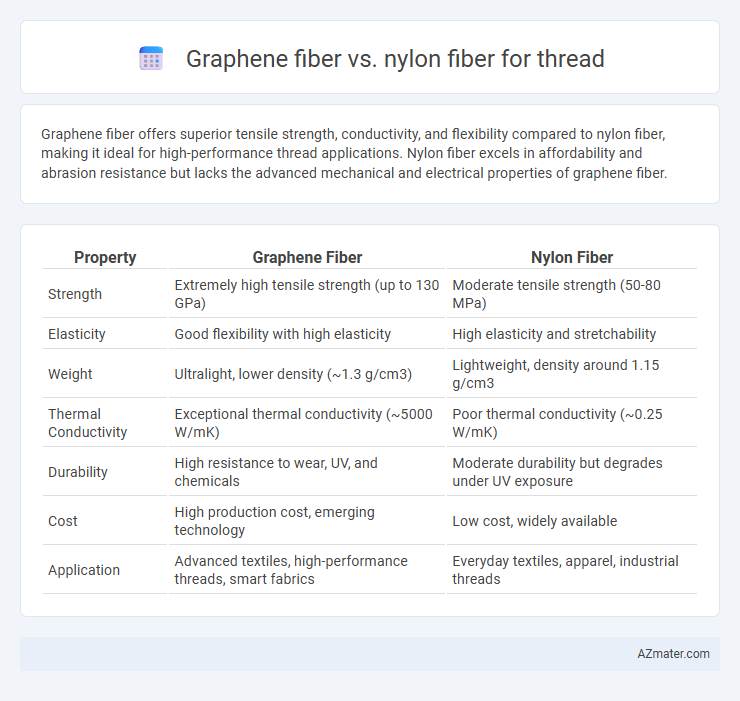Graphene fiber offers superior tensile strength, conductivity, and flexibility compared to nylon fiber, making it ideal for high-performance thread applications. Nylon fiber excels in affordability and abrasion resistance but lacks the advanced mechanical and electrical properties of graphene fiber.
Table of Comparison
| Property | Graphene Fiber | Nylon Fiber |
|---|---|---|
| Strength | Extremely high tensile strength (up to 130 GPa) | Moderate tensile strength (50-80 MPa) |
| Elasticity | Good flexibility with high elasticity | High elasticity and stretchability |
| Weight | Ultralight, lower density (~1.3 g/cm3) | Lightweight, density around 1.15 g/cm3 |
| Thermal Conductivity | Exceptional thermal conductivity (~5000 W/mK) | Poor thermal conductivity (~0.25 W/mK) |
| Durability | High resistance to wear, UV, and chemicals | Moderate durability but degrades under UV exposure |
| Cost | High production cost, emerging technology | Low cost, widely available |
| Application | Advanced textiles, high-performance threads, smart fabrics | Everyday textiles, apparel, industrial threads |
Introduction to Graphene Fiber and Nylon Fiber
Graphene fiber, derived from graphene's single-atom-thick carbon layers, offers exceptional tensile strength, conductivity, and lightweight properties, making it a revolutionary material for high-performance threads. Nylon fiber, a synthetic polymer known for its elasticity, durability, and resistance to abrasion and chemicals, remains a widely used thread material in textiles and industrial applications. Comparing graphene fiber to nylon fiber highlights advancements in strength-to-weight ratio and electrical conductivity that graphene fibers bring to thread technology.
Composition and Structure Comparison
Graphene fiber consists of carbon atoms arranged in a hexagonal lattice, offering exceptional tensile strength, electrical conductivity, and flexibility due to its single-layer graphene sheets structure. Nylon fiber is a synthetic polymer made of polyamide chains with a semi-crystalline structure, providing durability, elasticity, and resistance to abrasion and chemicals. The atomic-scale crystalline structure of graphene fiber results in superior mechanical and conductive properties compared to the polymeric, chain-oriented structure of nylon fiber commonly used in textile threads.
Mechanical Strength and Durability
Graphene fiber exhibits superior mechanical strength compared to nylon fiber, with tensile strength reaching up to 130 GPa, significantly higher than nylon's typical range of 50-80 MPa. Durability-wise, graphene's resistance to wear, chemical degradation, and environmental factors surpasses that of nylon, making it ideal for high-performance applications. The exceptional stiffness and lightweight properties of graphene fiber also contribute to longer-lasting thread products under extreme stress conditions.
Flexibility and Elasticity
Graphene fiber exhibits superior flexibility compared to nylon fiber, enabling it to bend and twist without breaking while maintaining structural integrity. Its elasticity allows for significant stretch and recovery, outperforming nylon by enhancing durability and resistance to deformation under stress. This combination of high flexibility and elasticity makes graphene fiber an advanced choice for threads requiring resilience and adaptability in dynamic applications.
Electrical and Thermal Conductivity
Graphene fiber exhibits superior electrical conductivity compared to nylon fiber, making it ideal for applications requiring efficient current flow and electromagnetic interference shielding. Its thermal conductivity significantly surpasses that of nylon, enabling better heat dissipation and enhanced thermal management in smart textiles and wearable electronics. While nylon fiber is flexible and durable, its insulating properties limit performance in electrically and thermally conductive thread applications.
Weight and Density Differences
Graphene fiber exhibits significantly lower density compared to nylon fiber, making it an ideal choice for lightweight thread applications where strength-to-weight ratio is critical. Nylon fibers typically have a density around 1.15 g/cm3, whereas graphene fibers demonstrate densities as low as 0.9 g/cm3 or less, contributing to lighter and more durable textile products. The reduced weight offered by graphene fibers enhances performance in aerospace, sportswear, and flexible electronics by minimizing material bulk without compromising tensile strength.
Environmental Impact and Sustainability
Graphene fiber demonstrates superior environmental benefits compared to nylon fiber due to its biodegradability and lower energy consumption during production, reducing carbon emissions significantly. Nylon fiber production relies heavily on petrochemicals, contributing to pollution and non-renewable resource depletion. The sustainability profile of graphene fiber is enhanced by its potential for recyclability and minimal ecological footprint, making it a more eco-friendly choice for textile applications.
Applications in Textile and Thread Industries
Graphene fiber offers superior tensile strength, electrical conductivity, and thermal regulation compared to nylon fiber, making it ideal for advanced textiles requiring durability and smart functionalities. Nylon fiber remains widely used in textile and thread industries due to its cost-effectiveness, elasticity, and resistance to abrasion, suitable for everyday apparel and industrial sewing threads. Emerging applications favor graphene-infused threads for wearable electronics, medical textiles, and high-performance sportswear, while nylon threads dominate mass production for garments and upholstery.
Cost and Commercial Availability
Graphene fiber, known for its superior strength and conductivity, remains significantly more expensive than nylon fiber due to complex production processes and limited manufacturing scale. Nylon fiber enjoys widespread commercial availability and cost-effectiveness, making it the preferred choice for mass-market thread applications. The high cost and scarcity of graphene fiber restrict its use primarily to specialized, high-performance textiles rather than everyday thread products.
Future Prospects and Innovations
Graphene fiber offers remarkable tensile strength and electrical conductivity, enabling the development of smart threads with applications in wearable technology and flexible electronics. Innovations in graphene fiber production aim to reduce costs and enhance scalability, positioning it as a sustainable alternative to traditional nylon fibers, which are valued for durability and easy processing but lack advanced functional properties. Future prospects highlight hybrid materials combining graphene's superior mechanical and conductive traits with nylon's resilience, driving breakthroughs in multifunctional textile industries.

Infographic: Graphene fiber vs Nylon fiber for Thread
 azmater.com
azmater.com